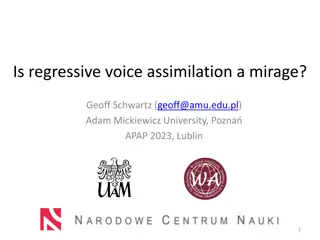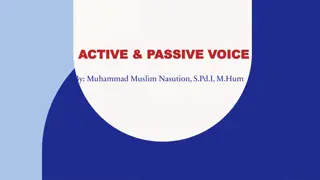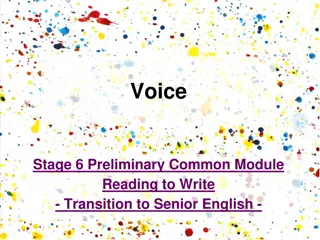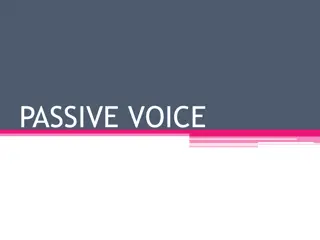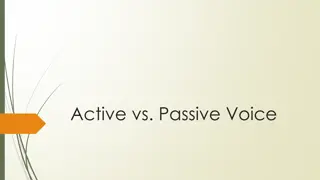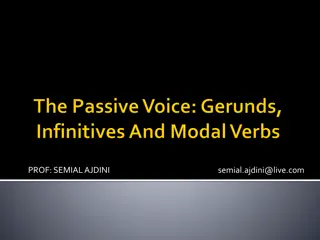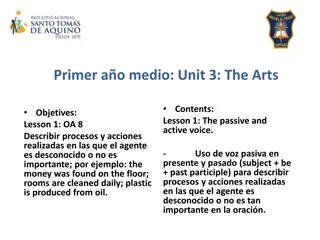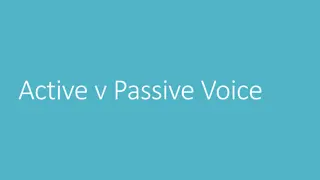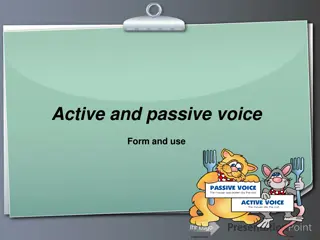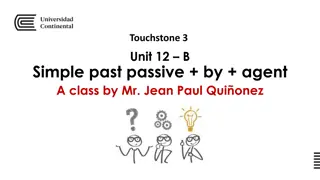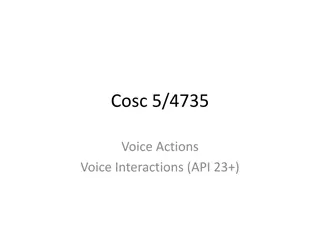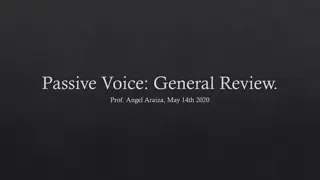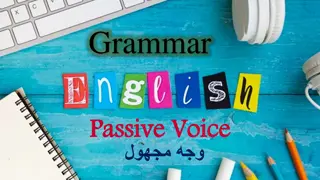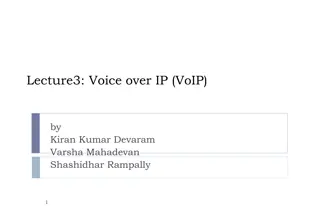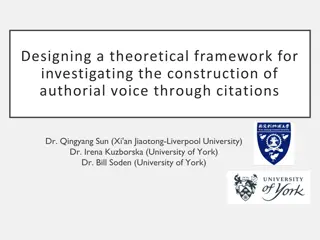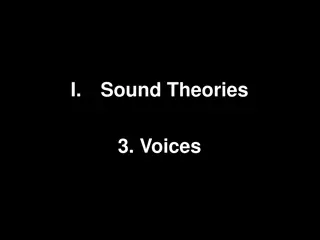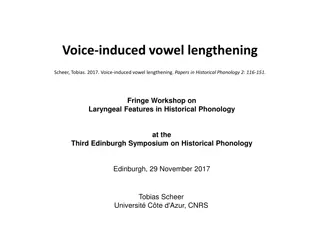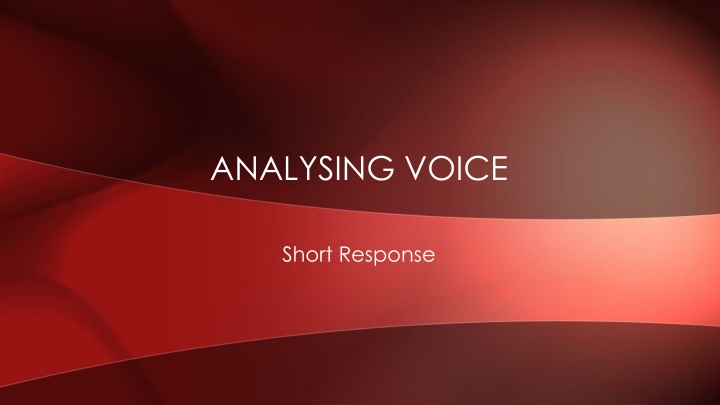
Narrative Voice and Tone in Writing
Explore the concept of narrative voice, tone, and attitude in writing, including authorial voice, point of view, and the construction of voice to shape audience response. Learn how tone articulates the attitude of a speaker and how different voices influence the reader's perception of a text.
Download Presentation

Please find below an Image/Link to download the presentation.
The content on the website is provided AS IS for your information and personal use only. It may not be sold, licensed, or shared on other websites without obtaining consent from the author. If you encounter any issues during the download, it is possible that the publisher has removed the file from their server.
You are allowed to download the files provided on this website for personal or commercial use, subject to the condition that they are used lawfully. All files are the property of their respective owners.
The content on the website is provided AS IS for your information and personal use only. It may not be sold, licensed, or shared on other websites without obtaining consent from the author.
E N D
Presentation Transcript
ANALYSING VOICE Short Response
RECOGNISING VOICE AND TONE Situation: 5 year old birthday party with $500 cake and professional entertainer, face painter and table loaded with presents. Write about it using sheet to change tone.
TYPES OF NARRATIVE VOICE / VOICE - GLOSSARY Authorial voice In the literary sense, voice can be used to refer to the nature of the voice projected in a text by an author; the persona, role or character adopted by an author. Narrative voice / point of view The ways in which a narrator may be related to the story. For example, the narrator might take the role of first or third person, omniscient or restricted in knowledge of events, reliable or unreliable in interpreting what happens. Voices in text As well as an author s voice, texts often contain multiple voices . These are the views, positions, ideas and perspectives of other individuals or groups. It is important to recognise the various voices in a text, how they relate to one another, and how the creator of a text uses these to shape audience response. Tone Tone describes the way the voice is delivered. For example, the tone of a voice or the tone in a passage of writing could be friendly or angry or persuasive.
WHAT DO THEY WANT YOU TO LOOK AT WHEN THEY USE THE TERM VOICE? Students demonstrate an understanding of: Persona, role or character (who are they and their perspective) Students need to be able to identify tone / attitude. Voice establishes the sound of a text and refers to the speaker or sense of personality evident in a text. Construction of voice is crucial in order to appeal to a specific audience or reflect / resist a particular context. It shapes the response of the reader.
TONE AND ATTITUDE Tone articulates the attitude of a speaker. A writer might convey a disgusted tone showing their outraged and furious attitude towards someone who had done something they think is morally wrong. David Attenborough uses a measured and serious tone to convey his fears about the state of the environment. His tone becomes more upbeat when he focuses on the ways we can help. His initial attitude is one of quiet despair, but his attitude changes as he looks at what people are doing and sees in that the possibility for a good outcome.
ATTITUDES CAN BE SHOWN THROUGH: Tone, reaction or feeling expressed toward a subject This includes characterisation in fiction texts (actions or dialogue) As an opinion or viewpoint stated or demonstrated by an individual.
STEP1 WHO? - IDENTIFY THE VOICE(S)? Step 1 Who is talking? What do we know about them? How might that affect their viewpoint? (For a narrative what kind of point of view? Tone/style?) Perspective / Context What groups do they belong to that affect their response (e.g. mother, business owner, a particular socio-economic or age group, gender, race, occupation etc.) What do they value? How is this shown in their attitude / tone?
STEP 2 HOW IS THE VOICE CONSTRUCTED? Language choices Punctuation Syntax Structure Patterns (repetition / changes / contrasts etc.)
STEP 3 IDENTIFY ANY CHANGES How and why? Does the voice change? (How) Does the tone change? (How) What happened to provoke this change? Change in attitude / viewpoint / context (Why)
STEP 4 SO WHAT? - CONTEXT AND CONNECTIONS Compare to other voices (including your own) Consider whether it is expected or unexpected? Consider whose voice dominates (privileged) and whose is silenced (marginalised) 1. In the world in text (their place in society) 2. By the text (their value to the reader) 3. In our society
HOW DOES VOICE CONVEY IDEAS? Read At Freedom by Helen Garner. Use steps to help explore text. 1. Who? (perspective) 2. How? (language etc.) 3. Changes? 4. So what?
PARA 1 SAMPLE - GARNER Garner s memoir initially invites me to see the relationship with her father as a strained one for Helen through her stressed and accusatory tone of voice. The capitalised detour sign with the exclamation Oh no! suggests she is panicked by the delay which combined with her description of herself as flustered and the mazes which plague the city implies she is feeling overwhelmed and hating the world around her for stopping her getting to her dad on time. This could be from love, but the assertive verb will be to describe her dad s likely reaction of pacing the lobby reinforces my initial impression by encouraging me to think that she is used to her father being quite demanding and unforgiving which fits the typical representation of the relationship between a cranky patriarch and his daughter.
PARA 2 SAMPLE The changes in Garner s tone encourages me to see her attitudes towards this relationship have changed by the end from stressful to more serene and accepting The contrasting description of the father as exchanging charming small talk rather than being cranky , and strolling grandly rather than pacing suggests he is more friendly old gent than patriarch which positions me to see she is re-evaluating: that she might have been too unsympathetic in her earlier expectations of him. However, his tone, in dialogue that follows, goes someway to reinforcing her initial attitude. He constantly questions everything she says and the dismissive way he sums up her likes as bullshit suggests he is abrasive and argumentative. This impression doesn t last though as the antagonistic tone ends as they start to laugh . Even though the outing is described as a mistake there is no stress in her voice and only relief at the end, along with the sense she has come of age and got past her sulks . Through her changing voice we see their relationship as becoming more healthy, with acceptance of their differences on both sides.

